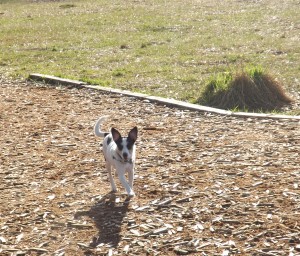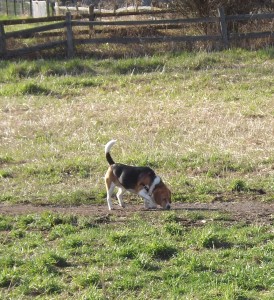At the Dog Park: 2 Tips for Better Recall
We have been pretty frequent dog park visitors ever since we got Larry three years ago. Right now, with me being unemployed, sometimes the only thing that gets me out of the bed is taking the dogs to the dog park, which means I take Larry and June almost every single week day. Because we are going in the morning when fewer people are there, we are also there when people who are a little less certain about their dogs and dog parks are around. So I have watched a lot of people struggle with recall for their dogs.
None of my dogs have ever had perfect recall, and I doubt they ever will. In a sense, this makes me the perfect person to give you recall tips for at the dog park. If your dog has perfect recall, you will never need these tips, and if you are a person who would have a dog with perfect recall, well, you already know how to train that. These are the two best tips I have for dogs (and owners) who are less than perfect.
Honestly, this is not something we learned until Junebug. The thing about Junebug is that she is a Beagle. She is sweet, and I am certain she likes us well enough as she knows we are her food providers, but we are not interesting. Her goal in life is NOT to make us happy. It is to follow her nose. This means that in order to get her attention, I absolutely must have something that is more interesting than whatever it is she is smelling.
I always carry the same treat, and I keep it in the same pocket. I make sure to give the dogs a treat sometime at the start of the dog park visit so they know I have them. After that, if I can get June to just look at me, I can reach a hand for the pocket where treats are kept, and she’ll come running.
If your dog is not food motivated, then replace high value treat with something that is high value for your dog- a squeaky toy, a tennis ball, whatever it is that your dog cares about most. If you can get their attention for just one moment, to see the high value whatever, you can get them to come running back to you.
 Do not be afraid to walk away.
Do not be afraid to walk away.
This is a hard one, a really hard one. In many cases, your heart will be yelling at you to do just the opposite- to follow your dog, to keep them in your sight. Walking away can feel like abandoning your dog. And yet, it is the most powerful recall tool I have ever had.
I do have one caveat for this one, though- make sure your dog is bonded to you. Do NOT try this tactic the second day you have your dog. In order for this to work, your dog needs to want to be near you, even if it is only for the reason that she knows you provide the food.
We learned about the power of walking away with Moree. Even when Moree escaped, he still did not want to go too far from us (unless he escaped with another dog, and then, he was golden, and he wouldn’t come back until the two dogs got split up, or he was ready for food and water). If we followed him, he would just go further, explore more, take more risks. Getting his attention and then turning and walking the other direction, was the one sure way to get him to come running back past us. In the neighborhood, it was how we directed him back toward the house. In the dog park, it was how we kept him moving in the direction we chose, or kept him from escaping.
I still use this tactic with Larry. At most of the dog parks we go to, Larry can jump the fence in at least one spot. While Junebug only requires a generic “shiny” to direct her attention away from us, Larry shows a bit more discrimination and requires “squirrel!” or, more often “bird!”. And over the fence he will go.
Since he is actively following something, he won’t even look at me, so bringing out the treat only helps to keep Junebug with me (instead of trying to find a way to follow him), but does nothing for getting Larry back. But here’s the thing- unlike June, Larry does live to make us happy. The thing he wants most in life is for us to be happy, and specifically, happy with him.
So, I walk away. I turn my back and walk the other direction (or continue on the path I was on inside the park). I call his name so he knows where I am, and so he can tell I am moving away from him. Every little bit, I’ll call “Larry, I’m this way.” But I keep moving. I keep moving away from him.
And depending on where he is- if he’s actually out of the park chasing a squirrel, it’s scary. I want nothing more than to chase after him in the woods. But he can go places I cannot. And standing 20 feet away from him, with no chance of getting to him, yelling his name, while he tries to figure out if he can climb a tree does neither of us any good.
But 30 seconds (sometimes a little bit more, but generally not much) of walking away does the trick. He’s suddenly back over the fence and running toward me, because the one thing he does not want is to be left behind, to be away from his pack.
This worked with Moree. It would have worked with Smokey, if Smokey had ever had any desire to be more than 10ft away from us to begin with. It works with Larry, and yes, it even works with nose to the ground Junebug.
I am not saying this is always the solution. You have to judge each situation on its own merits. If the dogs are running off together, walking away doesn’t work as well because they have each other. (And if both dogs have escaped the confines of the park, I do go out after them. But often my strategy is to get their attention and then turn and start walking back toward the park, catching them when they run past me. Larry and June are both infinitely easier to catch than Moree was.)
And yes, they do get rewarded with treat when they are back in the park with me or wrangled on their leashes. Coming back always gets rewarded, no matter how long it took.
No dog of mine will ever have perfect recall, at least not through any action of mine. But by using these two tips, almost no one at the dog park has to know that.

